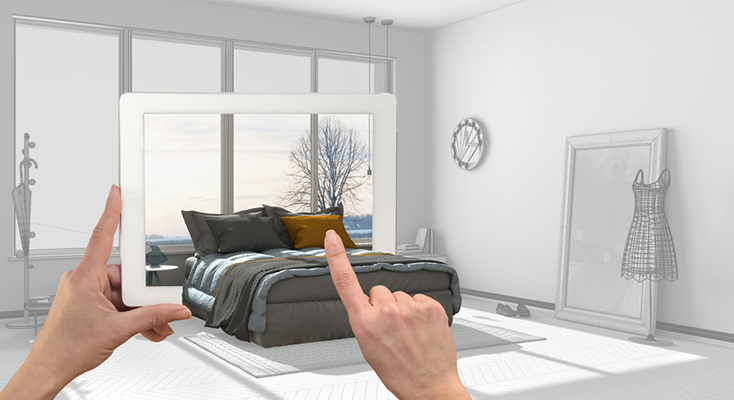Augmented reality (AR) has become a major component of the customer experience, allowing brands to create interactive experiences that transcend the boundaries of physical and digital. Since the release of Google Glass in 2014, investment in AR and VR technology has reached over $1 billion.
Although similar, AR & VR (Virtual Reality) are two different types of technology that often get confused. Augmented reality is the ability to view an enhanced version of reality as seen through the camera lens of a mobile device. Reality is enhanced by adding layers of digital information over the displayed image. For example, Snapchat filters allow you to take a live image and insert layers of different text and graphic elements over it. Virtual Reality, however, is when one wears a VR viewer or headset to be immersed in an entirely simulated environment.
Three companies utilizing AR technology to connect consumers to their products in new and inspiring ways are Sherwin-Williams, Georgia-Pacific and Amazon. Below are highlight examples that illustrate how these AR innovators are leveraging the technology to re-imagine the consumer product experience:
ColorSnap Visualizer App
Sherwin-Williams recently introduced AR capabilities into their ColorSnap Visualizer App. The app now allows users to view the walls of a room in their home via their smartphone camera and simultaneously “Paint a Scene,” meaning they can select paint colors to be applied to the walls of the room and virtually see how it looks in real-time. Home improvement has always been a hands-on task that can be time-consuming and costly, but this AR-enabled tool not only eliminates the trial-and-error process of testing new paint colors, but makes it easier to decide what colors look best in a particular room using the “Match a Photo” feature. The Match a Photo features allows you to upload a picture of a room you are looking to paint and through analysis of the furniture and decor, auto-generates a customized pallet of the colors it advises will work best with your room’s unique aesthetics.
Dixie Cups
After the success of PokemonGo, it’s no surprise that CPGs are now looking to connect children with their products using augmented reality games. Georgia-Pacific’s Dixie brand followed on PokemonGo’s success through the introduction of an augmented reality game for their bathroom cups that promotes dental hygiene among children. The parent can activate the game by downloading the Blippar app. Upon doing so, they are prompted to scan the AR-enabled cup with their mobile device. From there, the child’s mouth transforms on-screen into an animated “molar system” world. As the child brush’s their teeth, monsters appear that they can chase while earning “gold molars” along the way. The game lasts two minutes, the period recommended by the American Dental Association for tooth brushing, and works to help children establish better brushing habits by gamifying the experience. Georgia-Pacific isn’t stopping there with their kid-friendly cups though. They also have new 5oz cup designs that feature riddles and brain teasers, giving older children a chance to experience the AR-capabilities while they’re drinking or snacking.
Amazon
It’s no surprise that Amazon is one of the first-movers when it comes to integrating AR-capabilities into their shopping experience. Amazon shoppers can activate the AR tool by clicking the camera icon next to the search bar and clicking “AR view.” This brings the user to a listing of products available for testing with AR capability, including everything from home decor to kitchen appliances to electronics and children’s toys. Selecting a product prompts the user to point their camera to a flat surface where they would potentially want to place the item. From there, the user can manipulate the angle of the object or choose to view the product details and finalize the purchase. Through this feature, potential purchasers are able to view the product exactly as it would appear in true life, gaining a sense of the size and look of it in the context of their home or office space.
Augmented reality is already embedded into our daily lives and has shown its strength to be used as a key tool in the consumer market. Although it’s still in its early stages, by 2021, TechCrunch predicts that the AR market is expected to reach $83 billion, while its counterpart VR will reach $25 billion. These technological instruments may have once been seen more as a novelty, creating attention and buzz for advertisements and gaming apps, but the opportunity has evolved into so much more.
Companies like Sherwin-Williams, Georgia-Pacific and Amazon are just a few of the first-movers taking this tool and utilizing it to solve common shopping pain points, from having to test numerous paint colors to find just the right one—to purchasing a chair only to discover it doesn’t fit in your living room. As the perception and consumer exposure to AR grows, so too will the experiences companies can create with it.
References
https://www.huffingtonpost.com/dennis-williams-ii/the-history-of-augmented-_b_9955048.html
https://consumergoods.com/new-ar-infused-dixie-cups-give-boost-brushing
https://consumergoods.com/sherwin-williams-app-lets-consumers-try-colors
https://lifehacker.com/how-to-use-the-amazon-apps-ar-shopping-feature-1823362595


Comments are off this post